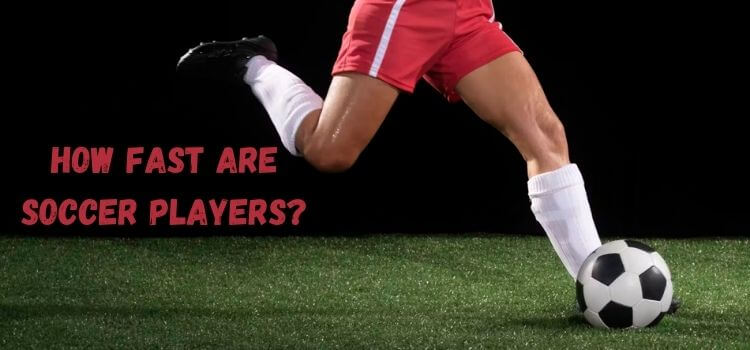As an Amazon Associate, I earn from qualifying purchases
Soccer, known for its dynamic and fast-paced nature, often showcases athletes with remarkable speed and agility. In this article, we delve into the intricacies of soccer players’ speed, exploring the factors influencing it, methods of measurement, comparisons across positions, notable players in history, training techniques, associated injury risks, technological advancements, cultural impact, and future trends.

Introduction to Soccer Players’ Speed
Speed is a fundamental aspect of soccer performance, contributing significantly to players’ effectiveness on the field. Whether it’s sprinting past defenders or swiftly changing direction to evade opponents, speed plays a pivotal role in determining the outcome of matches.
Factors Affecting Speed in Soccer Players
Genetic Factors
Genetics plays a crucial role in predisposing individuals to specific physical attributes, including speed. Some players may inherit favorable traits conducive to rapid acceleration and high velocity.
Training Methods
Effective training regimens tailored to enhance speed can significantly impact a player’s performance. Conditioning programs focusing on improving sprinting technique, agility, and explosiveness are commonly employed by coaches and athletes.
Muscle Fiber Composition
The composition of muscle fibers, particularly the proportion of fast-twitch fibers, influences a player’s ability to generate explosive bursts of speed. Training interventions may target these fibers to optimize speed development.
Measurement of Speed in Soccer Players
Timed Sprints
Timed sprints over specific distances serve as a traditional method of assessing a player’s straight-line speed. These tests provide valuable insights into acceleration and maximum velocity capabilities.
GPS Tracking
Modern technology allows for the use of GPS tracking systems to monitor players’ movements during training sessions and matches. Data collected includes distance covered, sprinting speed, and changes in velocity, offering comprehensive performance metrics.
Video Analysis
Sophisticated video analysis tools enable coaches to scrutinize players’ movements frame by frame, identifying areas for improvement in speed mechanics and decision-making processes.
Comparison of Speed Across Positions
Forwards
Forward players often rely on their speed to outrun defenders and create goal-scoring opportunities. Rapid acceleration and agility are prized assets in this position.
Midfielders
Midfielders require a balance of speed and endurance to transition between offensive and defensive phases effectively. Quick bursts of acceleration and the ability to cover ground swiftly are advantageous qualities.
Defenders
Defensive players must possess sufficient speed to track opposition attackers and thwart offensive threats. Tactical positioning and anticipation complement physical speed attributes in this role.
Goalkeepers
While goalkeepers may exhibit a different level of outfield speed, quick reflexes, and explosive diving movements are essential for shot-stopping and commanding the penalty area.
Fastest Soccer Players in History
Cristiano Ronaldo

Renowned for his lightning pace and athleticism, Cristiano Ronaldo has consistently demonstrated exceptional speed throughout his illustrious career.
Kylian Mbappé

A rising star in world football, Kylian Mbappé’s electrifying speed and dribbling prowess have garnered widespread acclaim, earning him comparisons to legendary players.
Gareth Bale

Gareth Bale’s explosive acceleration and powerful running style have made him a formidable force on the wing, capable of leaving defenders trailing in his wake.
The Importance of Speed in Soccer
Speed influences various aspects of gameplay, including offensive tactics and defensive strategies. Teams often capitalize on fast breaks and counterattacks to exploit opposition vulnerabilities and create scoring opportunities.
Training Techniques to Improve Speed
Sprint Drills
Structured sprint drills focusing on acceleration, deceleration, and change of direction help enhance a player’s speed mechanics and efficiency.
Plyometric Exercises
Plyometric training involving explosive jumping movements improves muscle power and reactive strength, facilitating rapid acceleration and agility on the field.
Strength Training
Strength training programs targeting lower body muscles, such as the quadriceps, hamstrings, and calves, contribute to improved force production and overall speed capabilities.
Injury Risks Associated with Speed
Hamstring Injuries
The high-speed nature of soccer increases the risk of hamstring strains, commonly occurring during sprinting and sudden accelerations.
Muscle Strains
Muscle strains, including quadriceps and calf injuries, may occur due to overexertion or inadequate warm-up protocols, impacting a player’s speed and mobility.
Overuse Injuries
Repetitive high-speed movements and training loads can lead to overuse injuries, necessitating proper recovery strategies and workload management to mitigate risks.
Technology Advancements in Measuring Speed
Wearable Devices
Wearable technologies, such as GPS trackers and accelerometers, provide real-time data on players’ speed, distance covered, and physiological parameters, aiding in performance monitoring and optimization.
Biomechanical Analysis
Advanced biomechanical analysis systems enable in-depth assessment of sprinting mechanics and gait patterns, facilitating targeted interventions to improve speed and reduce injury risk.
Cultural Impact of Fast Soccer Players
Speedy players often capture the imagination of fans worldwide, becoming icons celebrated for their exhilarating playing style and highlight-reel moments. Media coverage and marketing opportunities further elevate their status within the global football community.
Future Trends in Soccer Speed
The evolution of training methods and sports science is expected to drive further advancements in speed development and performance optimization. Integrating data analytics and personalized training protocols may revolutionize how players enhance their speed capabilities.
Conclusion
Speed remains a cornerstone of soccer performance, influencing tactical approaches, player recruitment, and fan engagement. Understanding the factors shaping speed in soccer players and implementing effective training strategies are essential for maximizing athletic potential and staying competitive in the dynamic landscape of modern football.
FAQs (Frequently Asked Questions)
While speed can be a valuable asset, technical proficiency, and tactical awareness are equally crucial for success in soccer.
Yes, sprint drills incorporating resistance training, such as sled pulls or hill sprints, can effectively enhance acceleration capabilities.
Agility complements speed by enabling players to change direction rapidly and evade opponents, contributing to overall fluidity and effectiveness on the field.
Injuries, particularly those affecting muscles and ligaments, can impede a player’s speed and mobility, requiring rehabilitation and careful management to regain optimal performance levels.
While genetics may influence an individual’s baseline speed potential, structured training programs focusing on speed-specific drills and conditioning can significantly enhance a player’s speed over time.
Read Our More Articles
- What Education is Needed to Become a Soccer Player?
- What Degree Do You Need to Be a Soccer Player? Get Facts Here
- How Do Soccer Players Slide So Far? A Comprehensive Guide
As an Amazon Associate, I earn from qualifying purchases


